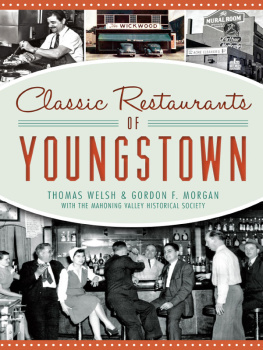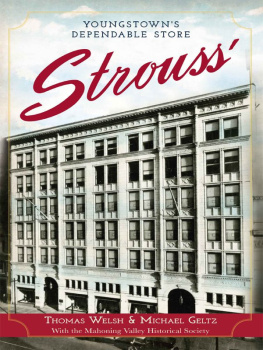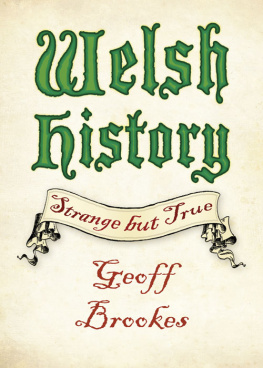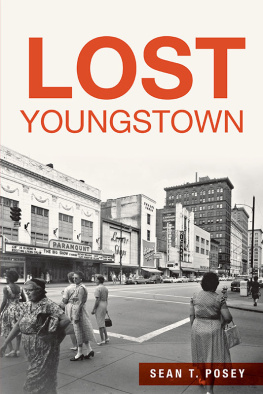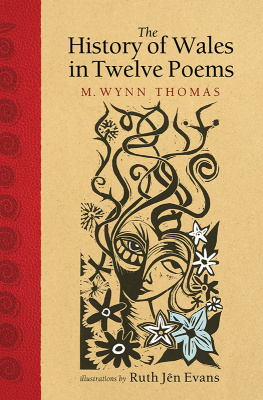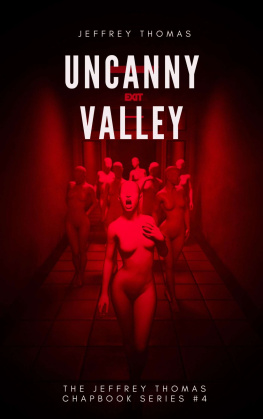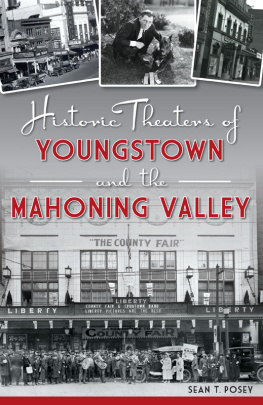Published by The History Press
Charleston, SC
www.historypress.net
Copyright 2017 by the Mahoning Valley Historical Society
All rights reserved
First published 2017
e-book edition 2017
ISBN 978.1.62585.641.8
Library of Congress Control Number: 2016945830
print edition ISBN 978.1.46711.896.5
Notice: The information in this book is true and complete to the best of our knowledge. It is offered without guarantee on the part of the authors or The History Press. The authors and The History Press disclaim all liability in connection with the use of this book.
All rights reserved. No part of this book may be reproduced or transmitted in any form whatsoever without prior written permission from the publisher except in the case of brief quotations embodied in critical articles and reviews.
List of Patrons
This book was made possible through the generosity of the following patrons:
Sherry and Gary Clayman
The Kessler and Mulne families, in honor of their parents and grandparents
Jeanne and Ken Fibus, with Amy and Bob Hendricks, Annie and Elle
Bill and Sandra Lippy
The Irv and Bea Ozer Endowment Fund
Judy and Sam A. Roth
Terry and Sam D. Roth
The Schwebel family
The Suzi Solomon Philanthropic Fund
Doris Tamarkin
Kay and Jerry Tamarkin
The Thomases Family Endowment of the Youngstown Area Jewish Federation
Marty White
An anonymous patron
To see in history a moral purpose and a task for a people on earth is a great discovery, far more important than the accounts of battles and intrigues that have plagued humanity from time immemorial.
Dr. Jacob Singer
Contents
Acknowledgements
The authors would like to thank the generous patrons of this project, as well as the many people who contributed their time, expertise and encouragement. We owe a special debt of gratitude to H. William Lawson, executive director of the Mahoning Valley Historical Society, who ensured that his organizations resources were available to us. At the same time, Pam Speis, archivist at the Mahoning Valley Historical Society, helped us navigate the organizations Jewish Archives, while spending hours reproducing articles and scanning images. We would also like to express our appreciation to William Philson, executive director of the Mercer County Historical Society, who assisted us in our research of Jewish communities in western Pennsylvania. Further help was provided by the research staff at Cincinnatis Hebrew Union CollegeJewish Institute of Religion. We also benefited from the cooperation of local news publications, including the Jewish Journal Monthly Magazine, the Vindicator and the Catholic Exponent. In addition, we received invaluable assistance from the researchers at the Public Library of Youngstown and Mahoning County, including Sara Churchill, Sally Freaney, Stuart Gibbs, Suzette Hinson, Judy Jones, Michele Mellor, Kathy Richter and Tim Sieman. We also received critical assistance from the staff members at the Warren-Trumbull Public Librarys Local History & Genealogy Center, including Elizabeth Glasgow, Michael Homlitas, Marisa Minich and Lucy Parker. As we wrote up the research, individual chapters were reviewed by H. William Lawson and Dr. Paul McBride, emeritus professor of history at Ithaca College. Local photographer Nea Bristol enhanced the project through her documentation of relevant landmarks. Meanwhile, Ronna Marlin, program director at Levy Gardens Assisted Living, facilitated interviews with residents and other members of the community. Throughout this journey, scores of individuals shared their memories and impressions of the Youngstown areas Jewish community. Given the scope of this project, it was not possible to incorporate all of their voices into the narrative. Nevertheless, we would like to thank the following individuals who enhanced our understanding of the communitys unique history: Louis Epstein, Brynna Fish, Daniel Greenfield, Rabbi Mitchell Kornspan, Solomon Jack Kravitz, Dr. Lawrence Kutler, George Livingston, Seth Malkin, Richard and Ronna Marlin, the Honorable Harry Meshel, Rabbi David Powers, Robert Rusnak, Bruce Sherman, Sonya Shultz, Elyse Silverman, Rabbi David Steinhardt and Dr. Milton Yarmy.
THOMAS G. WELSH, JOSHUA FOSTER AND GORDON F. MORGAN
May 25, 2016, Youngstown, Ohio
Introduction
You Will Always Be
Welcome in These Walls
On a sunny afternoon, June 4, 1886, members of the congregation of Rodef Sholom gathered for the dedication of their new temple, an elegant Moorish-style edifice that graced the corner of two main thoroughfares on Youngstown, Ohios North Side. The temple featured stained-glass windows and a domed turret. The spire could be spotted from the citys downtown retail district, a few blocks to the south.
For some observers, the building of Youngstowns first Jewish temple may have seemed overdue. Jewish immigrants had been present in the bustling manufacturing center since the late 1830s, when European-born Jacob Spiegel opened a general store in the citys downtown.
Among those on hand was the president of the congregation, David Theobald, who, in 1868, opened a subscription list and established a sinking fund for the purchase of property on which a temple would be built. Eighteen years later, as Rodef Sholoms gas-jet lights dimmed, a clear signal that the temples first service was about to begin, Theobald must have felt a strong sense of personal satisfaction.
Suddenly, the silence that enveloped the darkened interior of Rodef Sholom was broken, as Rabbi Henry Bloch knocked three times on the temples west door and shouted, Open ye the gates of righteousness, that we may enter and praise God. As the doors flew open, the officers of the temple, including Theobald, proceeded toward a raised platform, upon which stood a semicircular pulpit and a carved wooden sanctuary containing the first five books of the Hebrew Bible.
As the members of the procession seated themselves in chairs that were arranged on the platform, three young girls, each dressed in white and carrying a bouquet, approached Theobald and presented him with the key to the temple. Theobald lifted the key from a pillow held in the girls outstretched hands and stated, My dear little children: To receive this emblem of Gods trust, the key of this temple, from your hands, little daughters of Israel, is indeed a happy omen. He then turned to a crowd that included many of the communitys leading citizens and said, To the kind visitors and citizens of Youngstownto the authorities of this beloved city who show your kind sympathy by your presenceI have a right to appeal to you to look upon this edifice with looks of grace and consideration.
The words that followed were undoubtedly heartfelt, given the reports of vicious pogroms then coming out of Imperial Russia. Beside the array of other houses of prayer, this simply proves that we live in a happy land of divine peace and religious liberty, Theobald continued. You will always be welcome in these walls, and our prayers will be as much for your welfare as for ours.
Youngstown, with its diverse population and expanding economy, had indeed proven a hospitable venue for Jewish immigrants like David Theobald, who were welcomed into some elite spheres, even as they were excluded from others. Overall, these mainly German and Austrian immigrants had benefited from their relocation to a country where Jews held a relatively favorable (if rather ambiguous) position in an overwhelmingly non-Jewish society. This is not to suggest that cases of ethnic and religious intolerance were unknown. A particularly ugly incident that occurred in Youngstowns downtown district drew the concerned attention of a national Jewish journal. In 1873, thirteen years before the dedication of Congregation Rodef Sholom, a gang of youths accosted a young Jewish boy and tried to set him afire, stopping only when witnesses arrived on the scene. When questioned on their motives, the youths reportedly explained, We did it to punish the Jews for crucifying our Lord.




